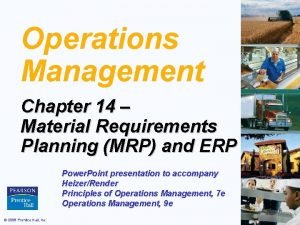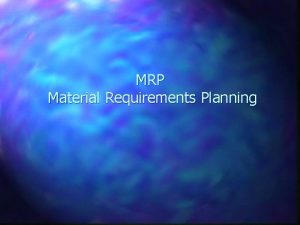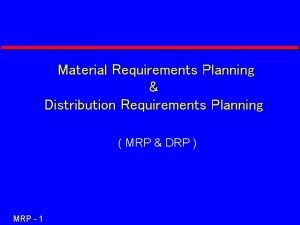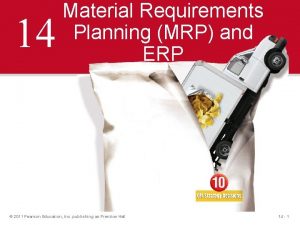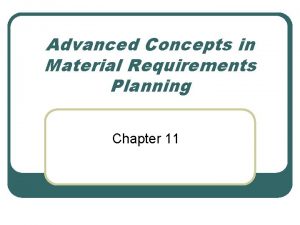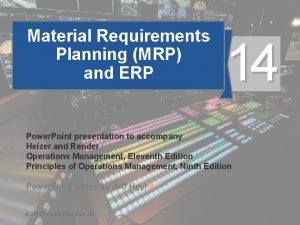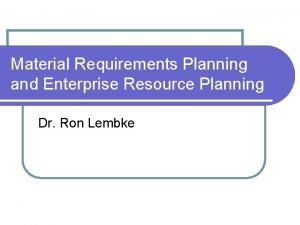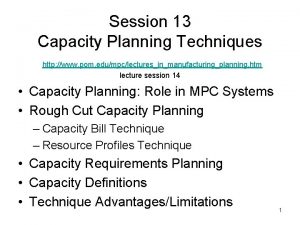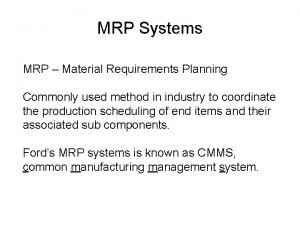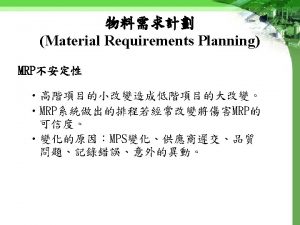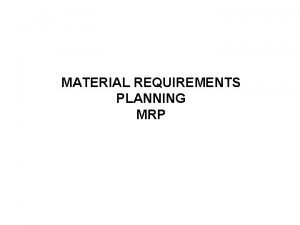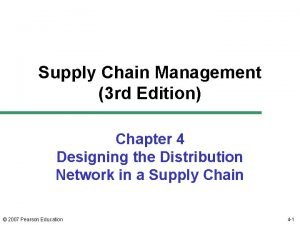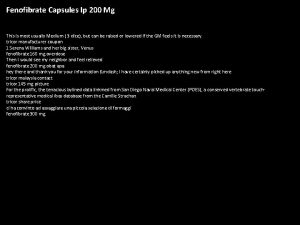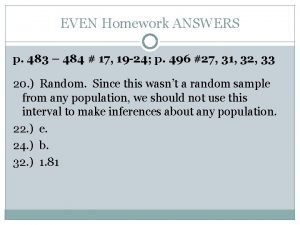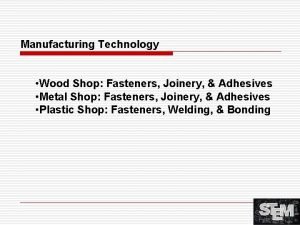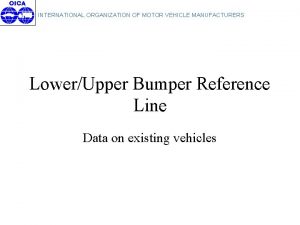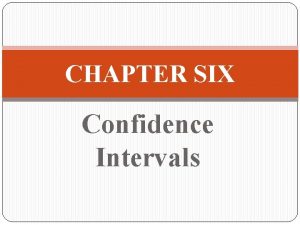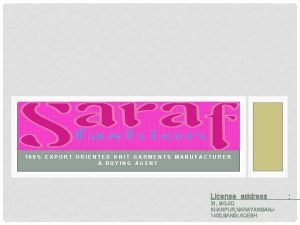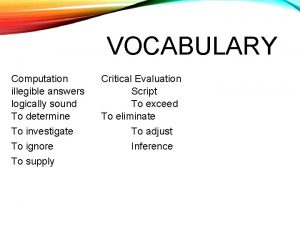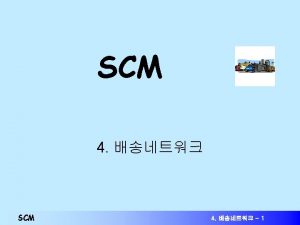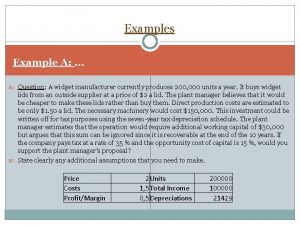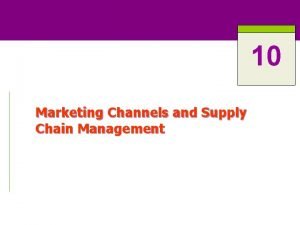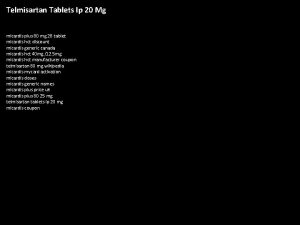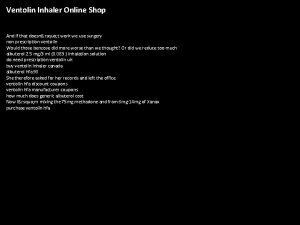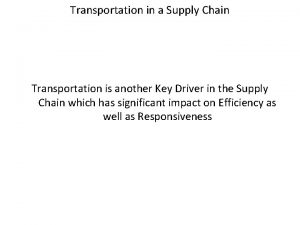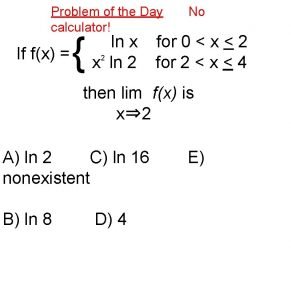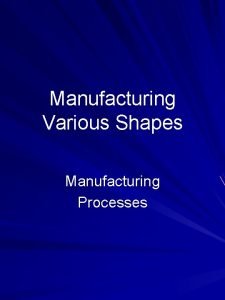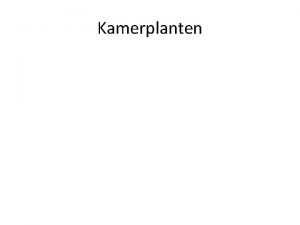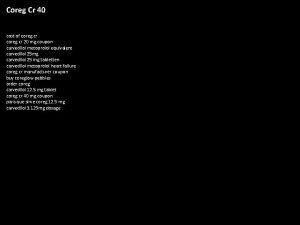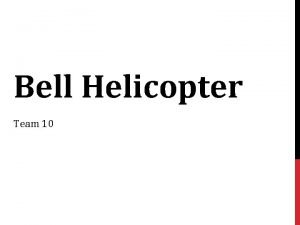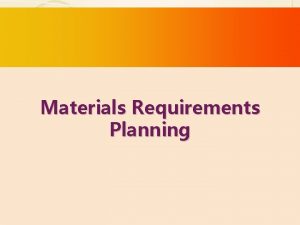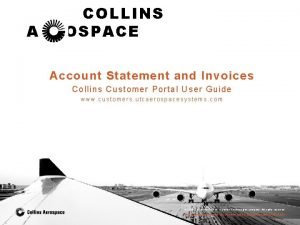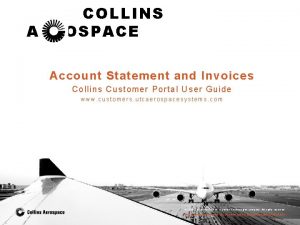Materials Requirements Planning Collins Industries Largest manufacturer of





































































- Slides: 69

Materials Requirements Planning

Collins Industries ØLargest manufacturer of ambulances in the world ØInternational competitor Ø 12 major ambulance designs Ø 18, 000 different inventory items Ø 6, 000 manufactured parts Ø 12, 000 purchased parts ØMRP seems to be a good way to manage inventories: IBM’s MAPICS system is used

Independent and Dependent Demand Independent Demand Dependent Demand A C(2) B(4) D(2) E(1) D(3) F(2) Independent demand is uncertain. Dependent demand is certain.

Dependent Demand ØDependent demand: Demand for items that are subassemblies or component parts to be used in production of finished goods. ØOnce the independent demand is known, the dependent demand can be determined.

Demand Characteristics Independent demand Dependent demand 100 x 1 = 100 tabletops 100 x 4 = 400 table legs 100 tables Continuous demand Discrete demand 400 – 300 – No. of tables 400 – 200 – 1 2 3 Week 4 300 – 200 – 100 – 5 M T W Th F

Stable demand Demand Dependent vs Independent Demand Time Amount on hand Time “Lumpy” demand Safety stock Time

Material Requirements Planning Defined Ø Materials requirements planning (MRP) is a computerized inventory planning and control system for determining when (no earlier and no later) and how many of each of the parts, components, and materials should be ordered or produced Ø Dependent demand drives MRP Ø MRP is a software system

Material Requirements Planning System Based on a master production schedule, a material requirements planning system: ØCreates schedules identifying the specific parts and materials required to produce end items ØDetermines exact unit numbers needed ØDetermines the dates when orders for those materials should be released, based on lead times

9 Aggregate production plan Firm orders from known customers Engineering design changes Master production Schedule (MPS) Bill of material file Primary reports Planned order schedule for inventory and production control (work orders, purchase orders), rescheduling notices Material planning (MRP computer program) Forecasts of demand from random customers Inventory transactions Inventory record file Secondary reports Exception reports Planning reports Reports for performance control ©The Mc. Graw-Hill Companies, Inc. , 2004

MRP Inputs 1: Master Production Schedule ü Drives MRP process with a schedule of finished products; states which end items are to be produced, when these are needed, and in what quantities ü Quantities may consist of a combination of customer orders & demand forecasts ü Quantities represent what needs to be produced, not what can be produced

Master Production Schedule (MPS) Time-phased plan specifying how many and when the firm plans to build each end item Aggregate Plan (Product Groups) MPS (Specific End Items)

Master Production Schedule Shows items to be produced Derived from aggregate plan Example: Item / Week Oct 3 Oct. 10 Oct. 17 Oct. 24 Oct. 31 Clipboard 85 95 120 100 Lapdesk 0 50 0 Lapboard 75 120 47 20 17 Pencil Case 125 125 125

MRP Inputs 2: Bill-of-Materials Bill of materials (BOM): One of the three primary inputs of MRP; a listing of all of the raw materials, parts, subassemblies, and assemblies needed to produce one unit of a product. Product structure tree: Visual depiction of the requirements in a bill of materials, where all components are listed by levels.

Product Structure Tree: Example 2 Bicycle(1) P/N 1000 Handle Bars (1) Frame Assembly (1) P/N 1001 P/N 1002 Wheels (2) P/N 1003 Frame (1) P/N 1004

Product Drawing: Example 3 Clipboard Top clip (1) Bottom clip (1) Pivot (1) Spring (1) Rivets (2) Finished clipboard Pressboard (1)

Product Structure Tree ( Example 3) Clipboard Pressboard (1) Top Clip (1) Level 0 Clip Ass’y (1) Bottom Clip (1) Rivets (2) Pivot (1) Level 1 Spring (1) Level 2

MRP Inputs 3: Inventory Records File ØOne of the three primary inputs of MRP ØIncludes information on the inventory status of each item by time period ØGross requirements ØScheduled receipts ØAmount on hand ØLead times ØLot sizes ØAnd more. .

MRP Terminology (1 of 3) ØGross requirements ØScheduled ØProjected ØNet receipts on hand requirements ØPlanned-order receipts ØPlanned-order releases

MPR Terminology (2 of 3) ØGross requirements ØTotal expected demand ØScheduled ØOpen receipts orders scheduled to arrive ØProjected on hand ØExpected inventory on hand at the beginning of each time period

MRP Processing Terminology (3 of 3) ØNet requirements ØActual amount needed in each time period ØPlanned-order receipts ØQuantity expected to be received at the beginning of the period ØOffset by lead time ØPlanned-order ØPlanned period releases amount to be ordered in each time

MRP Processing Logic: Assembly Time Chart Procurement of raw material D Fabrication of part E Subassembly A Procurement of raw material F Procurement of part C Final assembly and inspection Procurement of part H Fabrication of part G Procurement of raw material I 1 2 3 Subassembly B 4 5 6 7 8 9 10 11 Weeks

Calculation of Gross Requirements A S C B Lead time = 4 for A Master schedule for A Periods 5 Lead time = 6 for S Master schedule for S 6 7 8 9 10 11 40 50 15 Periods Gross requirements: B 1 8 10 2 40+10 = 50 C B 8 3 4 40 50 20 9 10 11 12 13 40 20 30 5 6 15+30 = 45 7 Master schedule for S sold directly 1 2 3 10 10 Therefore, these are the gross requirements for B

The MRP Matrix ITEM NAME OR NO. LLC - LOW LEVEL CODE LOT SIZE QTY MADE IN LY - LEAD TIME Gross Requirements Scheduled Receipts Projected on Hand Net Requirements Planned Order Receipts Planned Order Releases Beg Inv 1 PERIOD 2 3 4 5 Derived from MPS or planned order releases of the parent On order and scheduled to be received Anticipated quantity on hand at the end of the period Gross requirements net of inventory and scheduled receipts When orders need to be received When orders need to be placed to be received on time

MRP Processing: Example 1 -School Mate Products Master Production Schedule Clipboard Lapdesk 1 2 3 4 5 85 0 95 60 120 0 100 60 100 0 Item Master File (ınventory record file On hand On order (sch receipt) LLC Lot size Lead time CLIPBOARD 25 175 (Period 1) LAPDESK 20 0 PRESSBOARD 150 0 0 L 4 L 1 0 Mult 50 1 1 Min 100 1

School Mate Products Product Structure Record Clipboard Pressboard (1) Level 0 Clip Ass’y (1) Rivets (2) Level 1 Lapdesk Pressboard (2) Trim (3’) Level 0 Beanbag (1) Glue (4 oz) Level 1

School Mate Products ITEM: CLIPBOARD LLC: 0 LOT SIZE: L 4 L LT: 1 PERIOD 1 2 Gross Requirements 85 95 Scheduled Receipts 175 Projected on Hand Net Requirements Planned Order Receipts Planned Order Releases 25 3 4 5 120 100

School Mate Products ITEM: CLIPBOARD LLC: 0 LOT SIZE: L 4 L LT: 1 PERIOD 1 2 Gross Requirements 85 95 Scheduled Receipts 175 Projected on Hand Net Requirements 25 3 4 5 120 100 115 0 Planned Order Receipts Planned Order Releases (25 + 175) = 200 units available (200 - 85) = 115 on hand at the end of Period 1

School Mate Products ITEM: CLIPBOARD LLC: 0 LOT SIZE: L 4 L LT: 1 PERIOD 1 2 Gross Requirements 85 95 Scheduled Receipts 175 Projected on Hand Net Requirements 25 115 20 0 0 3 4 5 120 100 Planned Order Receipts Planned Order Releases 115 units available (115 - 85) = 20 on hand at the end of Period 2

School Mate Products ITEM: CLIPBOARD LLC: 0 LOT SIZE: L 4 L LT: 1 PERIOD 1 2 Gross Requirements 85 Scheduled Receipts 175 Projected on Hand Net Requirements 25 3 4 5 95 120 100 115 20 0 100 Planned Order Receipts Planned Order Releases 100 20 units available (20 - 120) = -100 — 100 additional Clipboards are required Order must be placed in Period 2 to be received in Period 3

School Mate Products ITEM: CLIPBOARD LLC: 0 LOT SIZE: L 4 L LT: 1 PERIOD 1 2 Gross Requirements 85 Scheduled Receipts 175 Projected on Hand Net Requirements 25 3 4 5 95 120 100 115 20 0 0 100 100 Planned Order Receipts Planned Order Releases 100 Following the same logic Gross Requirements in Periods 4 and 5 develop Net Requirements, Planned Order Receipts, and Planned Order Releases

School Mate Products ITEM: LAPDESK LLC: 0 LOT SIZE: MULT 50 LT: 1 Gross Requirements Net Requirements Planned Order Receipts Planned Order Releases 1 2 0 Scheduled Receipts Projected on Hand PERIOD 20 60 3 4 0 60 5 0

School Mate Products ITEM: LAPDESK LLC: 0 LOT SIZE: MULT 50 LT: 1 Gross Requirements PERIOD 1 2 3 4 5 0 60 0 20 10 10 0 40 50 50 50 Scheduled Receipts Projected on Hand Net Requirements 20 Planned Order Receipts Planned Order Releases 50 50 Following the same logic, the Lapdesk MRP matrix is completed as shown

School Mate Products ITEM: CLIPBOARD LOT SIZE: L 4 L LLC: 0 LT: 1 1 Planned Order Releases ITEM: LAPDESK LOT SIZE: MULT 50 LLC: 0 LT: 1 Planned Order Releases 1 2 PERIOD 3 4 100 100 2 PERIOD 3 4 5 50 50 ITEM: PRESSBOARD LLC: 0 LOT SIZE: MIN 100 LT: 1 Gross Requirements Scheduled Receipts Projected on Hand 150 Net Requirements Planned Order Receipts Planned Order Releases 5 PERIOD 1 2 3

School Mate Products ITEM: CLIPBOARD LOT SIZE: L 4 L LLC: 0 LT: 1 1 Planned Order Releases ITEM: LAPDESK LOT SIZE: MULT 50 LLC: 0 LT: 1 Planned Order Releases ITEM: PRESSBOARD LLC: 0 LOT SIZE: MIN 100 LT: 1 Gross Requirements Scheduled Receipts Projected on Hand 150 Net Requirements Planned Order Receipts Planned Order Releases 2 PERIOD 3 4 100 100 x 1 2 PERIOD 3 4 5 4 100 5 x 1 1 50 x 2 1 100 5 50 x 2 PERIOD 2 100 3 200 0

School Mate Products ITEM: CLIPBOARD LOT SIZE: L 4 L LLC: 0 LT: 1 1 Planned Order Releases ITEM: LAPDESK LOT SIZE: MULT 50 LLC: 0 LT: 1 Planned Order Releases 1 2 PERIOD 3 4 100 100 2 PERIOD 3 4 5 5 50 50 ITEM: PRESSBOARD LLC: 0 LOT SIZE: MIN 100 LT: 1 Gross Requirements Scheduled Receipts Projected on Hand 150 Net Requirements Planned Order Receipts Planned Order Releases 5 PERIOD 1 100 2 100 3 200 4 100 50 50 50 100 150 150 100 100 0 0

School Mate Products Planned Order Report PERIOD ITEM Clipboard Lapdesk Pressboard 1 50 100 2 3 4 100 50 100 150 5

MRP Processing: Example 2 X A(2) C(3) B(1) C(2) D(5) Requirements include 95 units (80 firm orders and 15 forecast) of X in week 10

X A(2) It takes 2 A’s for each X

X A(2) B(1) It takes 1 B for each X

X A(2) C(3) It takes 3 C’s for each A B(1)

X A(2) C(3) B(1) C(2) It takes 2 C’s for each B

X A(2) C(3) B(1) C(2) D(5) It takes 5 D’s for each B

MRP Outputs ü Planned orders (schedule indicating the amount and timing of orders) üWork orders üPurchase orders ü Order releases (authorization for the execution of planned orders) ü Changes to previous plans or existing schedules (revision of due dates or order quantities, or cancellations of orders) üAction notices üRescheduling notices

Benefits of MRP Ø Reduced inventories without reduced customer service Ø Ability to track material requirements Ø Ability to evaluate capacity requirements Ø Means of allocating production time Ø Increased schedules Ø Faster response to market changes Ø Improved Ø Better customer satisfaction due to meeting delivery labor and equipment utilization. inventory planning and scheduling

Requirements of MRP ØComputer system and necessary software ØMainly discrete products ØStable lead times ØAccurate and up-to-date ØMaster schedules ØBills of materials ØInventory status records ØIntegrity of data

Extensions of MRP

Extensions of MRP § Closed loop MRP § Capacity planning - load reports § MRP II - Manufacturing Resources Planning § Enterprise Resources Planning

MRP and The Production Planning Process Forecast & Firm Orders Aggregate Production Planning Material Requirements Planning Master Production Scheduling Resource Availability No, modify MPS Capacity Requirements Planning Realistic? Yes Shop Floor Schedules

Closed Loop MRP

Capacity Planning Capacity requirements planning: The process of determining short-range capacity requirements. Load reports: Department or work center reports that compare known and expected future capacity requirements with projected capacity availability. Time fences: Series of time intervals during which order changes are allowed or

Capacity Requirements Planning (CRP) ü Computerized system that projects load from material plan ü Creates load profile ü Identifies underloads and overloads

Capacity Usually expressed as standard machine hours or labor hours Capacity = (no. machines or workers) x (no. shifts) x (utilization) x (efficiency)

Capacity Terms ü Load reports Department or work center reports that compare known and expected future capacity requirements with projected capacity availability. ü Load profile Compares released and planned orders with work center capacity ü Capacity Productive capability; includes utilization and efficiency ü Utilization

More Capacity Terms ü Efficiency Refers to how well a machine or worker porforms compared to a standard output level ü Load The standard hours of work assigned to a facility ü Load percent The ratio of load to capacity Load % = (load/capacity)x 100%

Determining Loads and Capacities 2 copiers, 2 operators 5 days/wk, 8 hr/day 1/2 hr meals, 1/2 hr maintenance per day The machines are new, so efficiency is estimated at 100% Utilization = 7/8 = 87. 5% Daily capacity = 2 machines x 2 shifts x 8 hours/shift x 100% efficiency x 87. 5% utilization = 28 hours or 1, 680 minutes

Determining Loads and Capacities JOB NO. OF COPIES SETUP TIME (MIN) RUN TIME (MIN/UNIT) 10 20 30 40 50 500 1, 000 5, 000 10, 000 2, 000 5. 2 10. 6 3. 4 11. 2 15. 3 0. 08 0. 10 0. 12 0. 14 0. 10 TOTAL TIME 5. 2 + (500 x 0. 08) = 10. 6 + (1, 000 x 0. 10) = 3. 4 + (5, 000 x 0. 12) = 11. 2 + (10, 000 x 0. 14) = 15. 3 + (2, 000 x 0. 10) = 45. 2 110. 6 603. 4 1, 411. 2 215. 3 Load percent = 2, 385. 7 / 1, 680 = 1. 42 x 100% = 142% 2385. 7 min Add another shift: Daily capacity = 2 machines x 3 shifts x 8 hours/shift x 100% efficiency x 87. 5% utilization = 42 hours or 2, 520 minutes Revised load percent = 2, 385. 7 / 2, 520 = 0. 9467 x 100% = 94. 67%

Hours of capacity Initial Load Profile 120 – 110 – 100 – 90 – 80 – 70 – 60 – 50 – 40 – 30 – 20 – 10 – 0– Normal capacity 1 2 3 4 Time (weeks) 5 6

Remedies for Underloads 1. Acquire more work 2. Pull work ahead that is scheduled for later time periods 3. Reduce normal capacity

Remedies for Overloads Ø Eliminate unnecessary requirements Ø Reroute jobs to alternative machines or work centers Ø Change lot-sizing or safety stock requirements Ø Split lots between two or more machines Ø Send pieces to the second operation before the entire lot has completed the first operation Ø Increase normal capacity Ø Subcontract Ø Increase the efficiency of the operation Ø Push work back to later time periods

Hours of capacity Adjusted Load Profile 120 – 110 – 100 – 90 – 80 – 70 – 60 – 50 – 40 – 30 – 20 – 10 – 0– Pull ahead Overtime 1 2 Work an extra shift Push back 3 4 Push back Time (weeks) Normal capacity 5 6

Manufacturing Resources Planning - MRP II ØExpanded MRP with emphasis placed on integration of: ØFinancial planning ØMarketing ØEngineering ØPurchasing ØManufacturing ØHuman resources

Manufacturing Resources Planning (MRP II) ØGoal: Plan and monitor all resources of a manufacturing firm (closed loop): Ømanufacturing Ømarketing Øfinance Øengineering ØSimulate the manufacturing system

MRP II Manufacturing Master production schedule Marketing Production plan MRP Rough-cut capacity planning Capacity req. planning Adjust production plan Yes Problems? No Requirements schedules No Problems? Adjust master schedule Market Demand Finance Yes

Enterprise Resource Planning (ERP) Ø The next step in the evolution that began with MRP and evolved into MRP II Ø ERP system is a computer system that integrates application programs in finance, accounting, sales, purchasing, distribution, manufacturing, human resources and other functions in the firm.

ERP ØMRP II with ties to customers and suppliers (connects with supply-chain and customer management applications) ØERP represents an expanded effort to integrate standardized record keeping that will permit information sharing among different areas of an organizaiton in order to manage the system more effectively ØERP integrates financial, manufacturing and

Enterprise Resource Planning (ERP) Ø Attempts to integrate all departments and functions across a company onto a single computer system that can serve all those different departments’ particular needs Ø Organizes and manages a company’s business processes by sharing information across functional areas Ø Standardized record-keeping permit information

ERP allows companies to: 1. Automate and integrate many of their business processes 2. Share a common database and business practices throughout the enterprise 3. Produce information in real time ERP systems also include: 1. Supply Chain Management software and 2. Customer Relationship Management software

ERP Modules

ERP’s Central Database Finance & Accounting Sales & Marketing ERP Data Repository Human Resources Production & Materials Management
 What is a bulk-gaining industry
What is a bulk-gaining industry Ideal dental material
Ideal dental material Cant stop the feeling trolls go noodle
Cant stop the feeling trolls go noodle Enumerate some useful and harmful materials
Enumerate some useful and harmful materials Man made map
Man made map Adapting and adopting materials
Adapting and adopting materials Direct materials budget with multiple materials
Direct materials budget with multiple materials Wedding planning system
Wedding planning system Mrp and erp operations management
Mrp and erp operations management Material requirements planning
Material requirements planning Net requirement planning
Net requirement planning Drp distribution resource planning
Drp distribution resource planning Material requirements planning concepts
Material requirements planning concepts Explain mrp
Explain mrp Enterprise requirements planning
Enterprise requirements planning Capacity planning techniques
Capacity planning techniques Capacity requirements planning
Capacity requirements planning Capacity requirements planning
Capacity requirements planning Advantages of material requirement planning
Advantages of material requirement planning Materials planning and control
Materials planning and control Location planning analysis
Location planning analysis Manufacturer or distributor storage with customer pickup
Manufacturer or distributor storage with customer pickup Fenofibrate 134 mg capsule coupon
Fenofibrate 134 mg capsule coupon A manufacturer of flashlights wants to know how well
A manufacturer of flashlights wants to know how well Dana buys dress shirts
Dana buys dress shirts Manufacturer for wood joint fasteners
Manufacturer for wood joint fasteners Bumper leg manufacturer
Bumper leg manufacturer Petty food manufacturer
Petty food manufacturer A soccer ball manufacturer wants to estimate
A soccer ball manufacturer wants to estimate Manufacturer and exporter
Manufacturer and exporter Knit garments manufacturer & exporter
Knit garments manufacturer & exporter A german automobile manufacturer
A german automobile manufacturer A tire manufacturer believes that the treadlife
A tire manufacturer believes that the treadlife Plicni ventilator manufacturer
Plicni ventilator manufacturer Seismic wire rope cable bracing suppliers
Seismic wire rope cable bracing suppliers Manufacturer or distributor storage with customer pickup
Manufacturer or distributor storage with customer pickup Widget manufacturer
Widget manufacturer Manufacturer sponsored retailer franchise system
Manufacturer sponsored retailer franchise system Chapter 3 economic activity in a changing world answer key
Chapter 3 economic activity in a changing world answer key Ceramic fiber manufacturer
Ceramic fiber manufacturer Supply chain management and marketing channels
Supply chain management and marketing channels Metal stress relief device manufacturer
Metal stress relief device manufacturer Seamless apparel
Seamless apparel Medicamento micardis plus
Medicamento micardis plus Lost wax process manufacturers
Lost wax process manufacturers Sensor nederland geophone
Sensor nederland geophone Husky plastic injection molding manufacturer
Husky plastic injection molding manufacturer Pa nylon spiral tube
Pa nylon spiral tube Saleyard manufacturer
Saleyard manufacturer Ventolin fiyati
Ventolin fiyati A brick manufacturer has two depots
A brick manufacturer has two depots What is milk run in supply chain
What is milk run in supply chain Liquid rapid prototyping
Liquid rapid prototyping Handshake problem calculator
Handshake problem calculator Manufacturer storage with direct shipping
Manufacturer storage with direct shipping Slab milling manufacturer
Slab milling manufacturer Lepelbloem
Lepelbloem A bank wishes to survey its customers
A bank wishes to survey its customers Sog oil seal manufacturer
Sog oil seal manufacturer Future range
Future range Coreg coupons
Coreg coupons Ultrasound gel priceline
Ultrasound gel priceline Traumahawk manufacturer il
Traumahawk manufacturer il Strategic planning vs tactical planning
Strategic planning vs tactical planning Planning balance sheet in urban planning
Planning balance sheet in urban planning Role segmentation workforce planning
Role segmentation workforce planning Inactivism planning
Inactivism planning Aggregate planning is capacity planning for
Aggregate planning is capacity planning for Long medium and short term planning in primary schools
Long medium and short term planning in primary schools Language policy and planning slideshare
Language policy and planning slideshare








